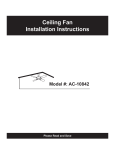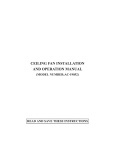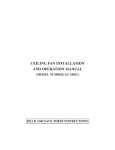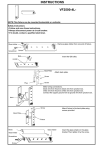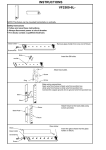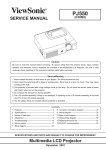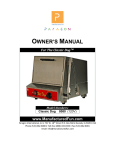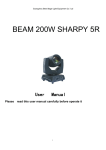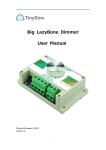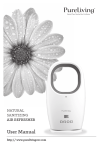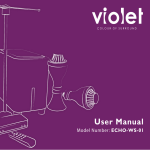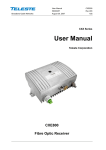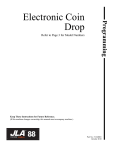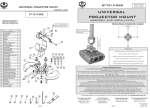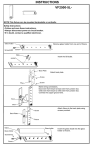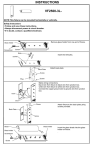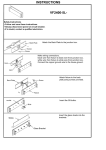Download Designers Choice Collection AC14652-CBRZ Installation Guide
Transcript
Ceiling Fan Installation Instructions Model #: AC-14652 Please Read and Save SAFETY PRECAUTIONS 1. To ensure the success of the installation, be sure to read the instructions and review the diagrams thoroughly before beginning. 2. All electrical connections must be in accordance with local codes, ordinances or National Electrical Code. If you are unfamiliar with methods of installing electrical wiring secure the services of a qualified electrician. 3. Make sure that your installation will not allow rotating fan blades to come in contact with any object. 4. If you are installing more than one ceiling fan, make sure that you do not mix fan blade sets. 5. If the fan will be mounted on a ceiling outlet box, a 4"x1/4" metal box is required. The box must be directly supported by building structure. The box and its support must be able to support the moving weight of the fan. The box must not twist or work loose. Do not use plastic boxes. 6. Installation to a concrete ceiling should be performed by a qualified electrician. 7. Before beginning, disconnect power by removing fuse or turning off circuit breaker. 8. After fan is completely installed, make sure that all connections are secured to prevent fan from falling. 9. Do no insert anything into the fan blades while ceiling fan is operating. 10. Fan must be turned off and stopped before reversing fan direction. 11. The fan must be mounted with the blades at least 2.3m from the floor to minimum the possibility of accidental contact with the fan blades. 12. The supply wires Live & Neutral must be connected to wall switch (double poles) having a contact separation at least 3mm in all poles. NOTE : The import safeguards and instructions appearing in the manual are not meant cover all possible conditions and situations that may occur. It must be understood that common sense. Caution and carefulness are factors which cannot be built into any product. These factors must be supplied by the person(s) caring for and operating the unit. WARNING WARNING The box must be supported directly by the building structure. The box and its support must be able support the fan weight - must not twist or work loose. Do not use plastic boxes. To reduce the risk of personal injury, do not bend the blades when installing the blades, balancing the blades or cleaning the fan. Do not insert foreign objects between rotating fan blades. Warning : To reduce the risk of fire, electric shock, or personal injury, mount to outlet box marked acceptable for fan support. MOTOR LEADS HANGER BALL/ DOWNROD ASSEMBLY CANOPY Putting your fan together 1. Pass the three motor leads through the opening in the canopy and coupling cover of fan. 2. Remove the two set screws from the motor coupling. Remove the hairpin clip & washer from the clevis pin and remove clevis pin from downrod. 3. Insert the downrod through the center opening in the canopy and route the motor leads through the hanger ball/ downrod assembly. Align the clevis pin holes in the downrod with the holes in the motor coupling. The clevis pin must pass through the holes in the motor coupling and the downrod. Place the washer onto the clevis pin and install the hairpin clip making sure to push straight leg of the hairpin clip through the hole near hanger ball to make sure the clevis pin is poroperly installed (see FIG 1). 4. Reinstall the 2 set screws in the motor coupling and securely tighten screws against the downrod assembly. COUPLING COVER WASHER COUPLING SET SCREW HAIRPIN CLIP CLEVIS PIN FAN FIG.1 METAL UL LISTED ELECTRICAL BOX 8-32 ROUND HEAD SCREWS WITH STAR WASHERS SUPPLIED HANGER BRACKET FIG.2 Hanging Your Ceiling Fan 1. Securely attach the hanger bracket to the outlet box by washers and screws supplied (see FIG 2). 2. Carefully lift the fan and seat the downrod and ball assembly on the hanger bracket. Be sure the groove in the ball is lined up with tab on the hanger bracket. Insert the receiver into the hanger bracket. Do not pinch wires between the ball and downrod assembly and hanger bracket (see FIG 3). METAL UL LISTED ELECTRICAL BOX HANGER BRACKET FIG.3 DOWNROD AND BALL ASSEMBLY GROOVE IN BALL 3. Install the safety cable into the building structure (see FIG 4). BUILDING STRUCTURE SAFETY CABLE Wiring Your Ceiling Fan Caution : To avoid possible electrical shock, be sure electricity is turned off at the main fuse box before wiring. 1. If you are not sure that the electrical box is grounded, contact a licensed electrician for advice. It must be grounded for safe operation. 2. Connect the black wire from receiver to the black wire from fan with wire nut. Connect the white wire from receiver to the white wire from fan with wire nut. Connect the blue wire from receiver to the blue wire from fan with wire nut. Connect the green wire from outlet box and the green wires from fan with wire nut (see FIG 5). 3. Loosen the two canopy mounting screws from the hanger bracket. Mount the canopy on the two screws in the hanger bracket and twist the canopy, so the screw heads hold the canopy in place. Retighten the two screws (see FIG 6). HANGER BRACKET WASHER WASHER FIG.4 SCREW BLACK WIRE GROUND WIRE BLACK WIRE WHITE WIRE WHITE WIRE BLUE WIRE GROUND WIRE BLUE WIRE FIG.5 HANGER BRACKET CANOPY SCREW FIG.6 Installing Blades 1. Attached each blade to the fan body using the blade screws & washers Tighten them securely (see FIG 7). SCREW WASHER Caution : To reduce the risk of personal injury, do not bend the blade when installing, balancing, or cleaning the fan. Do not insert foreign objects between rotating fan blades. FAN BLADE FIG.7 Installing the switch housing 1. Plug in the light wires from fan and the light wires from light fixture (see FIG. 8). 2. Plug the halogen bulb into the sockets. Do not touch the glass bulb with your fingers. It is extremely important that the glass be clean. If it is touched, or dirty, clean carefully with a tissue. A dirty glass bulb will cause the bulb to SCREW fail almost immediately (see FIG 9). FIG.8 3. Position the indentations in the outer rim of the glass shade so that they line up with the tabs on the inside surface of the fan light fixture rim. Carefully lift the glass shade up inside the light fixture as far as it will go. Rotate the shade in a clockwise direction until it is held tightly in place by the three tabs (see FIG 10). TAB FIG.9 Fan Airflow Direction PLUG LIGHT FIXTURE BLUB SOCKET 1. Slide the reverse switch to right or left to obtain opposite direction of airflow (see FIG 11). INDENTATION FAN FIG.10 GLASS COUPUING FIG.11 REVERSE SWITCH Operation in Summer In warm weather, the reverse switch should be set to produce a downward flow of air. The constant, gentle breeze will transfer heat from your body; thus, you will feel cooler even if the temperature remains unchanged. This cooling effect is referred to as a wind-chill factor. In an air-conditioned home, the wind-chill factor will allow you to set the thermostat higher than the usual setting. While using less energy to air-condition your home, you will stay just as cool. For summer cooling, set the speed control on medium or fast speed. This will provide sufficient airflow to accomplish a cooling effect. The exception to this is in bedrooms where a brisk, downward flow would be too chilly. A low-speed, gentle breeze is all that is necessary to keep you comfortable at night. Operating in Winter Winter comfort requires a different approach. Because warm air rises the air close to the ceiling is always warmerby perhaps 15¢XF-than the air close to the floor. To prevent heat from hovering where it does little good, move the reverse switch to create an upward airflow. This will pull cool air up and force warm air across the ceiling and down the walls. Set the variable speed control fast enough to break up the air stratification, but slow enough not to create a draft. By keeping the heat circulating, the heater will not have to operate as often to keep you warm.






